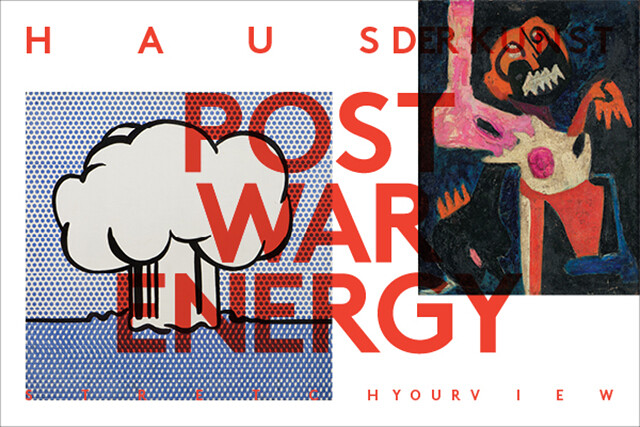October 14, 2016–March 26, 2017
Prinzregentenstrasse 1
80538 Munich
Germany
Hours: Wednesday–Monday 10am–8pm,
Thursday 10am–10pm
T +49 89 21127113
mail@hausderkunst.de
Haus der Kunst is proud to present Postwar: Art Between the Pacific and the Atlantic, 1945–1965, a major exhibition that explores the complex histories of art of the postwar era. For the first time in recent exhibition history, the exhibition examines the vibrant and turbulent postwar period as a global phenomenon in which artistic perspectives were intertwined with social, political, cultural, and technological interests.
In May 2014 Haus der Kunst launched its long-term research project in Munich with a four day international conference. Presenting research drawn from different regions of the world, the deliberations brought together leading and emerging scholars, historians, artists, curators, theorists, and students in order to examine the artistic forces and cultural legacies that have shaped the production of art since 1945.
The term “Postwar” describes the historical period following the end of World War II in 1945. These years delineate the decisive defeat of Germany in Europe and of Japan in Asia, marking a turning point in global history. In the field of art, the postwar period marks a particular historical and cultural turning point, too, for it brought about the waning dominance of Western European art capitals and the rise of the international presence and hegemony of contemporary American art, popular culture, and mass media. The state of the arts also revealed a distinct ideological fault line: behind the terms “socialist realism” and “abstraction” the simplifying binary between communism and capitalist democracy, socialism and liberal democracy was cast against the backdrop of the Cold War, which often obscured more complex motivations for artistic production.
On a global scale, however, several factors complicated this binary—decolonization struggles, independence movements, and anti-colonial resistance in Africa, Asia, and the Middle East—even as the Cold War powers courted and sought control of the new nations. These increasingly independent actors suggested quite different orientations and alliances—including pan-Africanism and the Non-Aligned Movement—in the wake of imperialism and the end of the war.
Reflecting on the varied trajectories of thinking of this period Postwar: Art Between the Pacific and the Atlantic, 1945–1965 maps the itineraries of art and politics that interlocked the world into a single entity. The question was asked everywhere: what would global modernity look like? If we are to refigure the cartographies of postwar modernism, what sort of methodologies might we deploy? To what extent did the political exert pressure on the aesthetic, or the cultural on the artistic? In turn, how did artists, critics, and intellectuals negotiate, resist, or even subvert political ideologies or cultural nationalism?
Probing differing concepts of artistic modernity—such as abstraction, realism, figuration, and representation—the exhibition explores how individual receptions and formulations of modernism informed the variant manifestations of modern art. By following these divergent and convergent vectors of influence, the exhibition invites reflection on the development of art that straddles continents, political structures, economic patterns, and institutional frameworks.
Yet in another sense, Postwar: art Between the Pacific and the Atlantic, 1945–1965 is entirely unprecedented, in that for the first time it examines art of the postwar era from multiple perspectives—East and West, North and South, colonizer and colonized, Pacific and Atlantic. Organized in eight thematic sections, Postwar illuminates these epochal social changes—Aftermath: Zero Hour and the Atomic Era; Form Matters; New Images of Man; Realisms; Concrete Visions; Cosmopolitan Modernisms; Nations Seeking Form; Networks, Media, and Communication.
As an in-depth, global study, the curators have conceived the exhibition across the practices of painting, sculpture, installation, collage, performance, film, artist books, documents, photography with more than 350 works by 218 artists from 65 countries.
The exhibition is curated by Okwui Enwezor (Director, Haus der Kunst), Ulrich Wilmes (Chief Curator, Haus der Kunst) and Katy Siegel (Eugene V. and Clare E. Thaw Endowed Chair in Modern American Art and Professor of Art History at Stony Brook University).
The exhibition is presented under the patronage of Frank-Walter Steinmeier, Foreign Minister of the Federal Republic of Germany.
The exhibition is accompanied by a comprehensive fully illustrated catalogue published by Prestel Publishing and edited by Okwui Enwezor, Katy Siegel and Ulrich Wilmes; with 36 new contributions. ISBN 978-3-7913-5584-9 (English edition), ISBN 978-3-7913-5583-2 (German edition).
Press contact:
Elena Heitsch, presse [at] hausderkunst.de
Concurrent with the opening of the exhibition on October 13, 2016 Haus der Kunst will launch the Postwar-Microsite. The microsite offers extensive information on the exhibition, the historical era, the featured artists, and all events connected to the exhibition. Please visit: postwar.hausderkunst.de
Subscribe for Haus der Kunst newsletter here.


